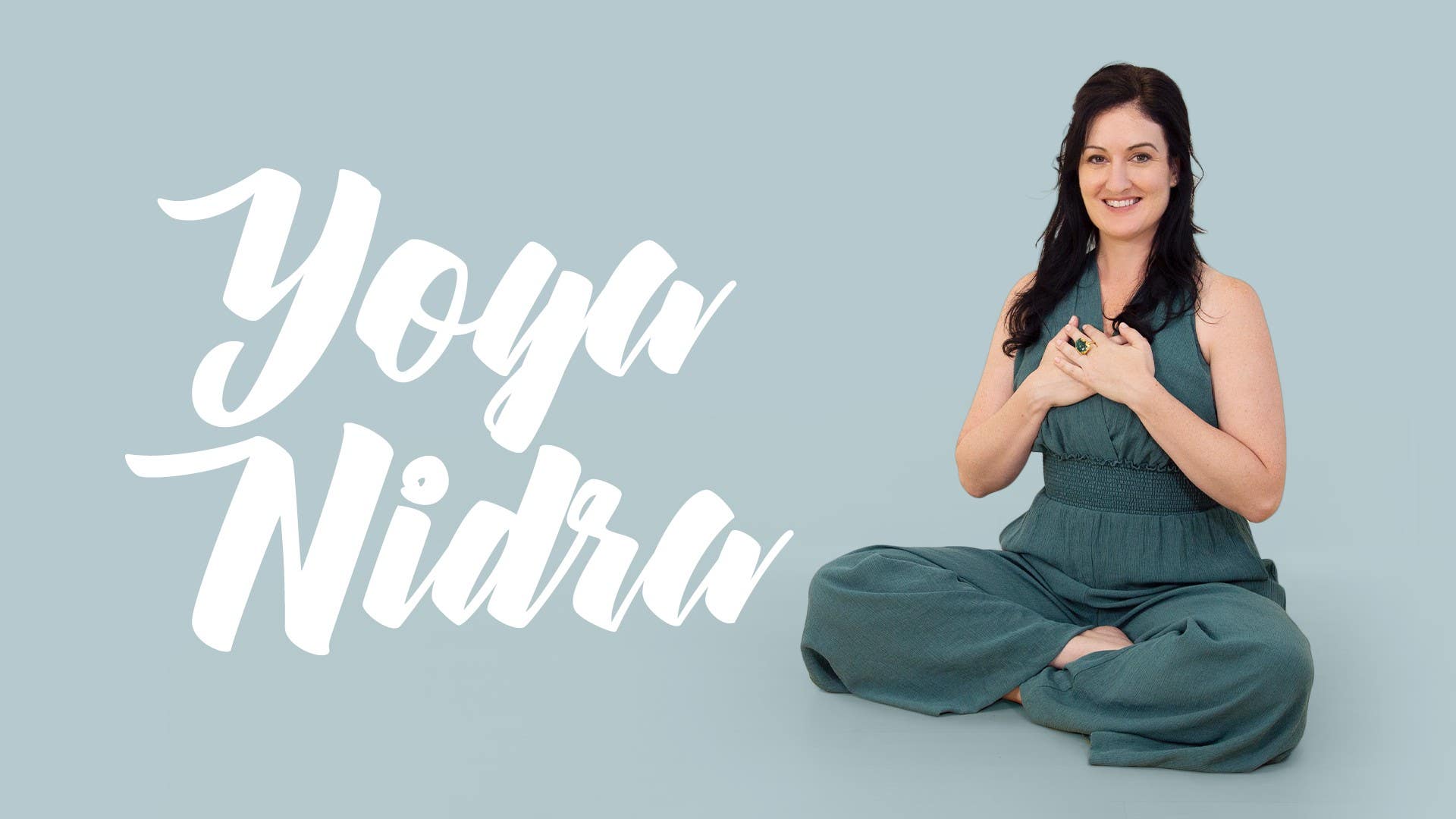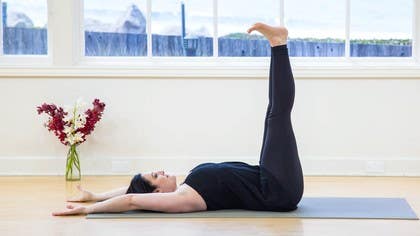Description
About This Video
Transcript
Read Full Transcript
Chapter 1
Yoga Nidra
Yoga nidra is not so much a set of practices or techniques. Yoga meaning union or to unite, nidra translates as sleep. It's not that we're going to sleep, but rather we're waking up to who we really are. It's a way to meet yourself beyond all the transient stuff, the body, the breath, the mind, all the patterns and limitations, but to really reveal the true essence of who you are as vastness. Yoga nidra is for everyone. It's available to us all at any time.
If you are in the midst of a huge turmoil or trauma, it might be better to practice these with a teacher in person, but otherwise this is a great practice accessible to anyone. You just have to have a sincere desire to do these practices. Nothing else is required of you. It's able to peel back the layers of you, leaving what's real. So we have to relax the physical body. This is the first step. If we're tense and tight and constipated and achy, the mind will not be able to move deeper than the physical body.
It will be distracted by it. So we start to unravel the physical tension, emotional, mental tension, and then what's left is who we really are as the part of us that's unbothered by any of that, the part of us that is unbound, infinite potential, the part of us that is unchanged, unchanging. Really the only obstacle to yoga nidra is you have to do the practice. It's just like all of these practices, they work, but you have to do them. So I think it's common to find resistance to these practices, resistance of slowing down, of being present, because when you land where you are, you start to notice achy bits in your body. You start to notice your breath being bothered, or your mind is just wild sometimes, and easily distracted, and it's hard to be with that.
You'll notice what you're actually feeling when you're quiet enough to stand still. So I think this is the challenge, and this is where the resistance comes, because we are so used to distracting ourselves with our smartphones, or a cat video, or Instagram. It's so easy to reach for something just so we don't have to feel what we're feeling or think what we're thinking. So it's the resistance, but unfortunately, cat videos and Instagram and our smartphones might be a temporary stress relief, but it's not lasting. As soon as we put it down, there we are again.
So yoga nidra is the practice of deep relaxation, but really meeting yourself in all of its glory. So in the yoga nidra practice, we use different techniques. So we use relaxation of the physical body, either by taking a little mental tour of the body, and conscious relaxation of different parts, or sometimes tensing and relaxing consciously different muscle or muscle areas. Then we can strip away and get to another deeper level of the pranic body, and we start to find balance in the pranic body by doing different breathing techniques or breath awareness. Then we start to tackle the mind.
We notice the patterns in the mind by bringing up different archetypes or images or visualizations, which will start to allow things to surface and release. And when all of that kind of clears, the part of you that's been watching all of that is revealed. It's kind of like the sun. You can forget it's sunny outside when all the clouds are covering it, but a stiff breathe blows all the clouds away, and the sun is revealed, ever present. We just become aware of it again. So we use breath as a tool, a technique in these practices.
Breath is the quickest way to enter the nervous system or to make changes in the nervous system. So sometimes we use conscious breathing and deeper breath in preparation for a yoga nidra practice to put us in that state where we're more receptive, where it can be relaxed and receptive to these teachings. We use visualization to start to allow for the surfacing of different thoughts and patterns and stuff that's stuck in our body. We create a little safe space for us to call upon those things so they're allowed to be seen and then released. You know your yoga nidra practice is working by the health of your relationships.
I think really all of yoga is like that. It's not so much that there are still times where I practice yoga nidra and it's a challenge. I'm distracted or I'm sleepy or I feel like I didn't reach some kind of state of yoga nidra. But the constant plugging in and the dedication of stepping into this stream of yoga nidra changes your relationships. So you can be more yourself and less buffered by all the noise.
The word yoga nidra shows up in some of the very old texts of the yoga practice. But at least in my understanding, the systematic practices of yoga nidra were never really elucidated. They were never talked about really in those texts. Just the word was used. You start to see the techniques running on a parallel track as Jungian philosophy, hypnotherapy, around that age which is somewhat recent if we're thinking of the whole scheme of things. You see a lot of overlap in a lot of these techniques where you're bringing up archetypes or visuals or guided relaxation.
So there seems to be some overlap and there's a few different big schools of yoga nidra. But the more I study it, the more I come to understand that it really is just a state of consciousness rather than a set system of techniques that you must or mustn't do. In the practice, we are moving through the states of consciousness. So we're moving from this awake state where we're engaged and we're taking in from the external world and trying to make sense of it. And when we do that, we are relying on our sense organs.
We're relying on memories and patterns and history and samskaras and all of these things to start knowing our place in the world and what we're seeing and unpacking all of that. And we move from that awake state to the state of sleeping, the dream state. In the dream state, our mind is still active, our body is quiet, our body is even, there's almost a paralytic quality, our body is not moving, deeply relaxed. But our mind is still going and in that state things are released from our day. Or something that we hadn't consciously thought of but starts to arise, like little bubbles from the bottom of the riverbed start to bubble up to the surface to be expressed.
So archetype images start to show themselves. And then we move from that dream state to the deep sleep state, which is beyond image, beyond sense impression, beyond memory. And then there's a state after that, a state of turya, a state of beyond, of where you meet yourself, the part of you that's not transient, the part of you that's not moving and investigating and searching, the part of you that is whole, that is infinite potential, your true self, only in that silent space do you meet her again. Yoga nidra means sleep, but we're not going to sleep. So we do have a very heavy pattern, a heavy samskara of we get in bed, we get cozy, we pull the blanket up, we go right to sleep, unconsciousness.
Yoga nidra is the sleep of the yogis. So it's sleep with a seed of awareness still. So it's not about going unconscious, but it's about bringing consciousness in this deeply relaxed state. So it's sleep with a seed of awareness. I think yoga nidra allows me the opportunity to check in every day.
Even as a professional yogi, I am torn and tousled by my mind and shifts in my body or self-consciousness. It's a daily place for me to drop in and to remember who I am. And I need to touch that space every day, otherwise you can just drown in the noise and then you're no good to anyone, least of all yourself. I think sometimes if you're working with a lot of anxiety, the practice can be a little terrifying and necessary. So it's hard to give yourself the space to be quiet because then you hear exactly what's going on, whether it's depression, a tidal wave of emotion, or fear, or the mind just going a thousand miles a minute.
And it's hard to look at it, to be with it. And necessary. When you're not looking at it, it gets worse. There's no escaping it. It just keeps presenting itself. But when you give yourself a space, when you create hatha yoga, the word has a few different meanings, but one of the words I like is it's baked.
It's not baked, but it means to bake the vessel because when you're making a pot, if you don't throw it in the fire, it can hold nothing. The water that you pour into the vessel just disintegrates the pot. It goes everywhere. You have to put it in the fire. And then it becomes a strong enough vessel to hold it all. And these are what these practices do for us.
They make us a strong enough vessel that we can hold everything. We can see ourselves and our sadness and our anxiety and our depression and our thoughts and our patterns and all this stuff. And we're strong enough to hold it, and it loses its pull. And it becomes like, oh, you again. I see you. I'm familiar. But it loses its claws. And we make ourselves a capable, strong enough vessel that we can hold it.
We can see it. We're bigger than it.
Chapter 2
The Koshas
The yogis of old saw us as multidimensional beings. So we have this dense physical body, this meat suit, as I like to call it, which changes. We age. It changes. We gain weight. We lose weight. We have a little crick in our neck one day and above me.
It's in a constant state of being born, living, and dying. It's this constant transient state. And behind that or beyond that, we're also this layer of prana, this layer of energy, of breath, which is also transient. The breath comes and goes and comes and goes and changes and is influenced and is very changeable. Beyond or beneath that, we have a layer of mind and emotion, of thought, of feeling. Transient comes and goes, is born, lives and dies. It goes through this cycle, ever-changing.
Behind or beneath that, we have a part of us that's observing all of that transience, this kind of seed of awareness that is not buffered or bothered by all of that transient, but rather is unchanging, is the watcher. And when we recognize that place, we realize it's not bound or limited to us, but it's interwoven and interdependent and interconnected to everything else, this kind of ocean of awareness around us, just a little drop from that ocean. And we get to drop back in. And so instead of thinking of all of these as distinct layers, different layers of clothing that we're putting on, they really are connected. So how we breathe affects our body.
How we move our body affects our mind and emotions. It is one complex organism or multidimensional creature. The koshas, anamaya kosha, pranamaya kosha, they all have the word kosha, which means actually sheath, like a sword in sheath. They all have the word maya in it. And maya means, sometimes it gets translated as illusion.
But I like the translation, when you look at Sanskrit and you break it up into its little words, you get a little bit more richness sometimes. And when you look at maya, we have maya and yah, which comes to mean the measure of the mother. So these are the measure of the mother of Shakti. So we have anamaya kosha, we have the food body, physical body, the measure of the mother. We have pranamaya kosha, or the breath body, measure of her.
Manomaya, the mind or emotion, vigna maya kosha, the layer of intellect, wisdom, the inner teacher, the witness. And then ananda maya kosha, the bliss body, the part of us that is connected. I think the koshas offer us a model or a map, a weigh-in, and maps are useful. We get lost, a map will help bring us back home. So this model or map of the koshas is very systematic.
As yogis, we're very used to working with our physical body. And we start to recognize that our breath, our mind, our physical body are very interwoven and affect one another and shift. When we do that enough, times we recognize there's part of us that's not shifting. That's just the silent observer, this vastness within us. And from there it's easier than to recognize it in each and every one of us and feel that connectedness.
So the koshas really are a map, a way to navigate the GPS of the soul. I think there's a lot of systems of yoga nidra that use the koshas as their map, a way of systematically moving from the dense to the subtle, through these systemized techniques, practices, moving to that kind of center of who you are as already whole.
Chapter 3
The Chakras
The way I understand the energy body is that it's really a system of these different maps and models and really quite poetic maps and models of the experience of being alive in these bodies. So we could have an experience of love and quite often we'd point here to our chest like, I love you instead of I love you. There's a gut instinct, gut feeling, or a lump in my throat, I couldn't find the words.
And we all have this experience, this very common experience of being alive in these forms. And to express that we need a map, we need a model. And the chakras give us this very beautiful map of what it's like to be in these bodies and move around and feel and interact. And so moving through the chakra system is just really this way of poetically moving through our experience of being alive. Chakra has a few different meanings like all Sanskrit words depending on who you ask.
Most commonly I hear wheel or vortex, but it's the headquarters of the elements in your body. The amount of earth and water and fire and air and space. These have a headquarter in your form. One of my teachers, Alan Finger, likes to equate it to the little icons you see on your iPhone. You have all these cute little icons and you double click them and a whole folder and a whole world of information opens.
It's like these chakras, you double click on them through mantra or breath or visualization and a whole world of information that's contained within them opens. There's many different systems of chakras. Most commonly studied today it's the seven chakra system. And they really are seen through the length of the spine or through the center line of the body. So we have the earth element or muladhara chakra, these base needs.
We have the water center as vadisthana chakra, our attachments, our aversions, kind of like the tides pushing and pulling. It's also the area of creativity, of shakti, of sexuality. We have the fire center of manipura where our sense of self, of ego, but not as a bad word, but a sense of dharma of purpose resides. Our air center of anahata chakra, heart loving for no reason at all, this loving compassion. We have vishuddha at the throat, this purification center, this highway between the heart and the brain or the emotion in mind or jiva and brahman, this way of communicating between the two.
And then agnya chakra, the seed of intuition, of self-realization. And then sahasra chakra, the crown chakra, the thousand pedaled lotus, our connection to source, to one another, to the infinite. I think chanting really helps me bypass my critical mind, critical thinking mind, often critical mind, and really lands me in the heart really quickly more so than any other practice, brings me into anahata chakra. It brings me into a state of just, of loving, as Alan says, loving for no reason at all. Not the lover or the loved, but loving.
And the practice of chanting brings me there without fail.
Yoga Nidra
Comments
You need to be a subscriber to post a comment.
Please Log In or Create an Account to start your free trial.

















